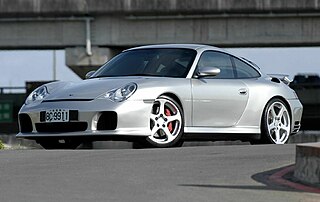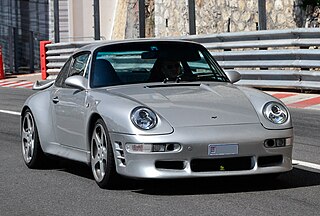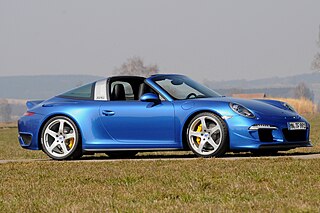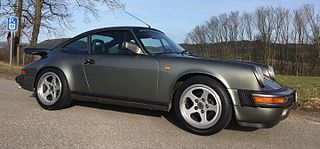
The Porsche 924 is a sports car produced by Porsche in Neckarsulm, Germany, from 1976 until 1988. A two-door, 2+2 coupé, the 924 replaced the 912E and 914 as the company's entry-level model.

The Porsche 930 is a turbocharged variant of the 911 model sports car manufactured by German automobile manufacturer Porsche between 1975 and 1989. It was the maker's top-of-the-range 911 model for its entire production duration and, at the time of its introduction, was the fastest production car available in Germany.

The Porsche 993 is the fourth generation of the Porsche 911 model sports car manufactured and sold between January 1994 and early 1998, replacing the 964. Its discontinuation marked the end of air-cooled 911 models.

The Porsche 996 is the fifth generation of the 911 model sports car manufactured by the German automaker Porsche from 1997 until 2006. It was replaced by the 997 in 2004, but the high performance Turbo S, GT2 and GT3 variants remained in production until 2006. The 996 had little in common with its predecessor, with the first all new chassis platform since the original 911 and a new water-cooled engine. Technically, it was a major change, a complete break from the original car other than the overall layout.

The Porsche 997 is the sixth generation of the Porsche 911 sports car manufactured and sold by the German automobile manufacturer Porsche between 2004 and 2013. Production of the Carrera and Carrera S coupés began in early 2004, all-wheel drive Carrera 4 and Carrera 4S began to be delivered to customers in November 2005, the Turbo and GT3 derivatives went on sale in late 2006 and the GT2 in 2007. In addition to the coupé and cabriolet versions, Targa versions of the Carrera 4 and Carrera 4S were also available, which carry on with the "glass canopy" roof design used since its first application on the 993 until the 991, which reverted to the classic targa top layout used on the early 911 Targas.

The Porsche 964 is a model of the Porsche 911 sports car manufactured and sold between 1989 and 1994. Designed by Benjamin Dimson through January 1986, it featured significant styling revisions over previous 911 models, most prominently the more integrated bumpers. It was the first car to be offered with Porsche's Tiptronic automatic transmission and all wheel drive as options.

Ruf Automobile GmbH is a German car manufacturer. Formerly using Porsche bodies in white to build cars, today they build vehicles on their own bodies and chassis. They also manufacture performance parts for various Porsche models, including the 911, Boxster, and Cayman.

The Ruf CTR2 is a 2-door sports car built by German automobile manufacturer Ruf Automobile from 1995 to 1997 as the successor to the CTR Yellowbird, but based on Porsche's Type 993 generation 911.

The Porsche 911 GT3 is a high-performance homologation model of the Porsche 911 sports car. It is a line of high-performance models, which began with the 1973 911 Carrera RS. The GT3 has had a successful racing career in the one-make national and regional Porsche Carrera Cup and GT3 Cup Challenge series, as well as the international Porsche Supercup supporting the FIA F1 World Championship.

The Ruf CTR also known as the CTR Yellowbird or simply Yellowbird, is a limited-production, high performance sports car manufactured by German automobile manufacturer Ruf Automobile. Introduced for the 1987 model year and based on the Porsche 911, the CTR featured an enlarged and highly tuned version of Porsche's 3.2 litre flat-six cylinder engine, lightened body panels, an integrated roll cage, upgraded suspension and braking systems, a custom-designed transmission, and several unique trim pieces such as polyurethane bumpers, and the use of the side-mounted oil filler necessitated by relocating the oil tank forward to clear the intercooler on that side.

The RUF RT 12 is a sports car built by RUF Automobile of Germany and based on the 997-generation Porsche 911.

The Ruf CTR3 is a mid-engined sports car produced by German car manufacturer Ruf Automobile. The CTR3 was unveiled at the Bahrain International Circuit on the 20th anniversary of the original Ruf CTR on April 13, 2007 in conjunction with the opening of a new Ruf factory at the circuit.

The Ruf RTurbo is a sports car built by Ruf Automobile of Germany and introduced in 2001. It is based on the 996 generation Porsche 911. It was offered with a choice of 520 hp (388 kW), 550 hp (410 kW), and 590 hp (440 kW) engines. The RTurbo could be had as either a complete Ruf car with unique VIN or a conversion for an existing 996 retaining the original Porsche VIN.

The Ruf BTR is a sports car built by German automobile manufacturer Ruf Automobile. The BTR began production in 1983 and was based on the Porsche 911 available in a narrow 911 or optional wide body configuration akin to the 930 Turbo. The BTR was the first Ruf production sports car with a company specific VIN.

The Ruf Turbo R, sometimes stylized as TurboR, is a sports car built by Ruf Automobile of Germany. It is based on the 993 generation Porsche 911 Turbo. It was introduced in 1998 after the discontinuation of the CTR2, however Ruf still wanted a supercar offering to be available and so the Turbo R became the supercar offering from Ruf for the 1998 model year and endured a very short production run of only one year.

The Porsche 911 is a two-door 2+2 high performance rear-engined sports car introduced in September 1964 by Porsche AG of Stuttgart, Germany. It has a rear-mounted flat-six engine and originally a torsion bar suspension. The car has been continuously enhanced through the years but the basic concept has remained unchanged. The engines were air-cooled until the introduction of the 996 series in 1998.

The Ruf Turbo Florio is a two-seater sports car produced by German car manufacturer Ruf Automobile. It was unveiled at the 2015 Geneva Motor Show. The name of the car comes from the Targa Florio, a Sicilian road race after which Porsche's targa top cars are also named. The Turbo Florio is based on the Porsche 991 Targa 4 platform, with significant changes made to the body, engine, and structure of the car.

The Ruf SCR is a rear-engined sports car manufactured by German automobile manufacturer Ruf Automobile. Introduced in 2018, the styling of the SCR 2018 is inspired by the Porsche 911 (964) and its introduction pays homage to the original Ruf SCR, but the new SCR uses a completely bespoke carbon-fibre monocoque chassis and body work.

The Ruf BTR2 is a sports car produced by Ruf Automobile. Based on the Porsche 993 Carrera, it succeeded the original BTR. The BTR2 was among the fastest road cars of its time, attaining a top speed of 308 km/h (191 mph).

The Ruf SCR is a sports car manufactured by German automobile manufacturer Ruf Automobile. The SCR was based on the Porsche 911 SC and the changes made to its engine enabled it to have similar performance to the 930 Turbo, despite having a naturally aspirated engine.




















